Understanding how your audience feels about your product or service is paramount to any marketing strategy.
To build a comprehensive brand marketing strategy, you should know what people struggle with and what they enjoy about your products. You should also know how their attitude to your brand changes in response to product launches, marketing campaigns, and outside events.
Fortunately, the world of technology is evolving all the time, and now sentiment analysis tools can provide that data.
What is sentiment analysis?
Sentiment analysis is a method of text analysis that uses machine-learning and natural language processing to determine whether the sentiment behind a piece of writing is positive, negative, or neutral.

Why is it important to perform sentiment analysis for your target audience?
Sentiment analysis uncovers information that can't be discovered in any other way. Big Data reveals your overall brand reputation and does the same for your competitors. Just having that data will improve your brand marketing strategy, but there are also less apparent ways you can use the information revealed by sentiment analysis.
How can you use the information gathered by sentiment analysis tools?
1. Flag customers for active communication
Analyzing sentiment around your competitors' brands shows you the customers who are unhappy with your competitor's products or services. If they are criticizing an issue that your product doesn't have, you can easily swoop in with an attractive product offer.
If the sentiment analysis shows customers who are unhappy with your own brand, you can reach out to them and attempt to solve their issues.
Sentiment analysis tools can also reveal customers who are actively satisfied with your brand—i.e., they post positive things about your brand online. You might want to reach out and ask them to leave testimonials on your site or become an affiliate or brand advocate.
2. Uncover hidden conversations about your business
Sentiment analysis shows you the pain points and happiness points of your company. If your brand is popular, you'll uncover entire discussions online that you can join to showcase your expertise or present your solutions.
You can approach the conversations about your business in two ways. The first is to act as a company representative: speak as an expert, promote your brand, answer questions and complaints.
You can also encourage your brand advocates to join in those discussions as inspired customers and thus promote your brand in a more subtle and possibly more persuasive way.
3. Keep a closer eye on your competition
Performing sentiment analysis for your competition is no less important than doing so for your own brand. You'll find out what their customers are happy and unhappy about, and will be able to steal their good practices and avoid their mistakes.
For example, you can analyze how your competitor's most recent marketing campaign turned out. You can't usually get access to exact financial results, but you can find out whether the competitor's target audience liked or disliked the campaign, what they said about it, and how much traction it received.
In addition, you can see which demographic was most satisfied with the campaign and which was least satisfied. If your competitor is an international brand, you can see how countries differed in their responses.
4. Understand your own messaging better
Sometimes, marketing campaigns, slogans, and ideas don't work out as planned. Sometimes, you end up promoting a message you didn't intend to promote.
Sentiment analysis reveals the reaction to your every word early on. If you say or do something insensitive, only sentiment analysis tools have a chance of catching the problem before it blows up.
Since the rise of social media, brands' social media posts, marketing campaigns, and business decisions have frequently caused social backlash that could have been prevented with a sentiment analysis tool.
Even if you aren't planning on anything controversial, it makes sense to know how people feel about the message you send out into the world.
5. Create a more holistic approach to your online presence
Social media marketing and other digital marketing strategies often go unassessed. We don't know exactly what's working and what isn't. We don't know the extent of the social media buzz and its effect on brand awareness and brand reputation.
Sentiment analysis is a part of the solution in that it makes us more aware of our online presence. It turns vague feelings the target audience has about our brand into numbers, and it helps us create better marketing strategies.
Top 5 Sentiment Analysis Tools
Now that we've hopefully agreed that sentiment analysis can be useful for your brand, let's move on to the tools that perform it for you.
1. Awario
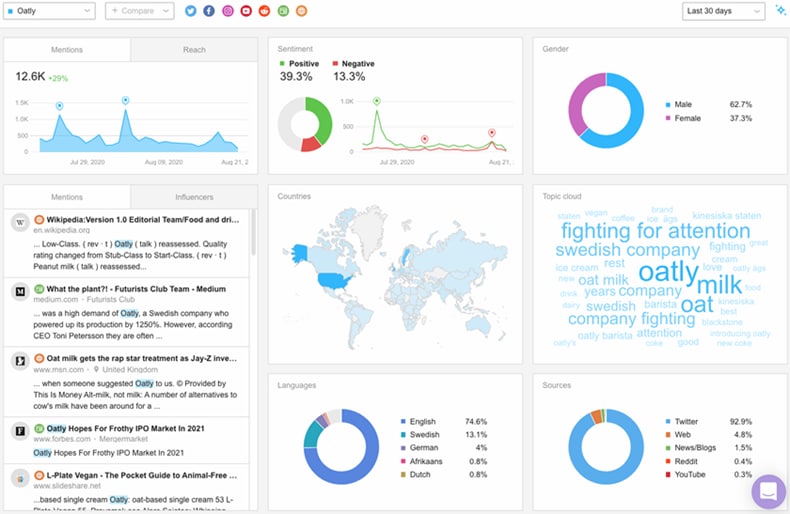
Awario (an app developed by my company) is a social listening (also called social media monitoring) tool, and sentiment analysis is one of its prominent features.
The tool crawls all major social media networks, news sites, blogs, forums, and other parts of the Web for mentions of any keyword. Usually, the keyword will be your brand or your competitor's brand, but it can also be your product, industry, CEO, or whatever else you choose.
Awario's sentiment analysis sorts all mentions into positive, negative, and neutral categories, and also shows how sentiment and growth change over time. You can choose to see only positive or only negative mentions, mentions from someone with a large following, or mentions from someone from a specific location.
You can dig deeper to find out exactly what the positive or negative mentions say.
Awario will also notify you if there's a sudden increase in positive or negative mentions so you can react in time.
Pricing: $29/month for the Starter plan, $89/month for Pro, and $299/month for Enterprise. Free 7-day trial available.
2. Brandwatch
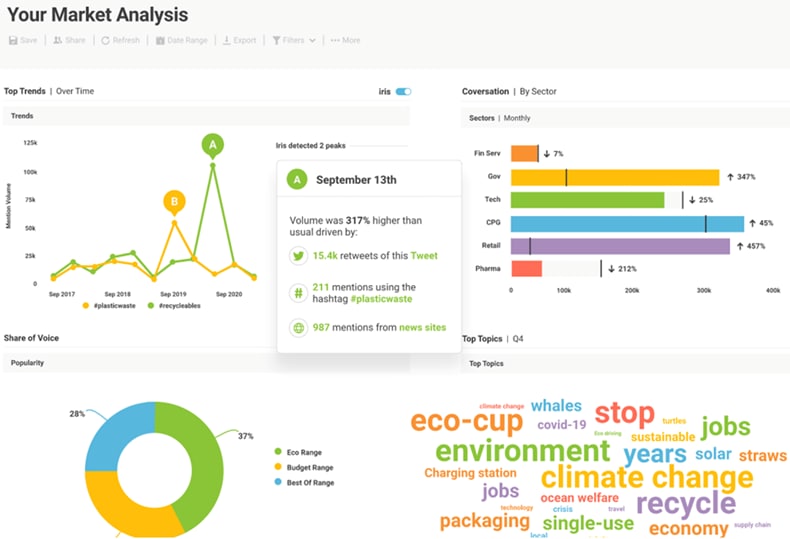
Brandwatch is another social listening and analytics tool that also performs sentiment analysis. An enterprise-level tool, it covers every source you can possibly think of, including specific social networks such as Tumblr and Goodreads, and local social networks such as VK. If there is a source that you need but can't find on Brandwatch, you can request to add it manually.
Brandwatch analyzes your data in many ways that include sentiment analysis and growth analysis. It also gives you insights into the authors of the accounts: Negative mentioners can be broken down by demographic so you can understand which parts of your target audience have the most complaints.
Brandwatch also shows trends and detects patterns in your data, and it notifies you if something unusual is happening.
Pricing: Available upon request.
3. Talkwalker
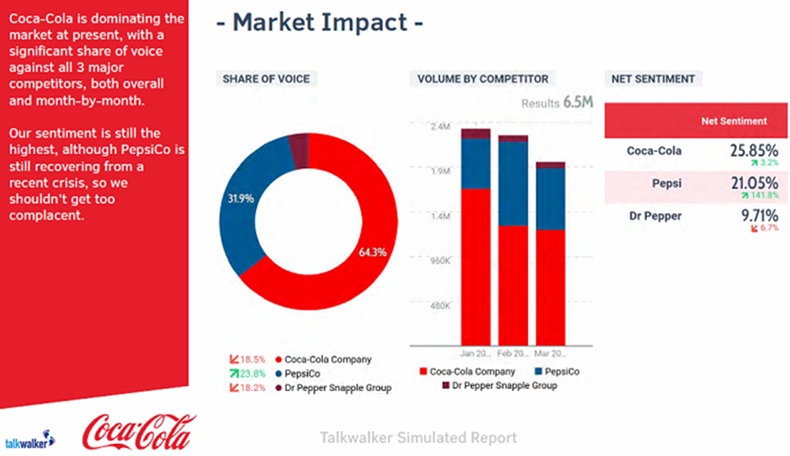
Talkwalker is a social listening tool that does much more than just listen. Like Brandwatch, it covers an unlimited number of sources, including social networks, news sites, review sites, blogs, forums, and other parts of the Web.
Talkwalker claims to have one of the best sentiment analysis technologies for detecting sarcasm. It also shows customer satisfaction trends, uncovering features of your products that are liked and ones that are disliked.
If you want to dig deeper into your data, you can filter the results by the type of service. For example, you can find out what customers are unhappy about with the type of food your airline provides.
Pricing: Basic is €6,000 yearly. Corporate and Enterprise pricing are available upon request.
4. Lexalytics
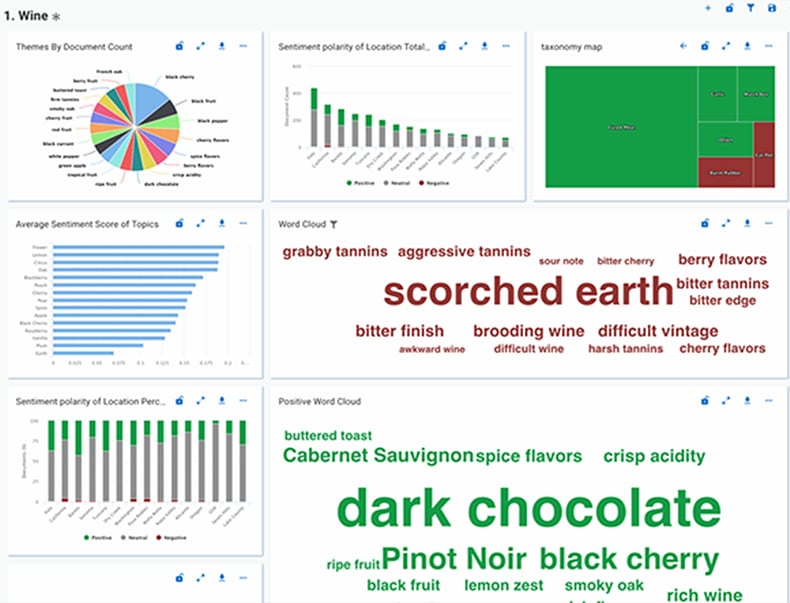
More than a social listening tool, Lexalytics is a business intelligence solution that analyzes many kinds of text among its extensive list of features.
Lexalytics covers social comments, reviews, surveys, and other text documents. The data is subjected to sentiment analysis, as well as categorization, theme extraction, and intention detection. That way, the tool ensures that it has detected the sentiment as precisely and in as much detail as possible.
Such a multifactorial approach also allows the user to understand the context and see the benefits and failures of their business in a whole new light.
Pricing: Available upon request.
5. Hootsuite Insights
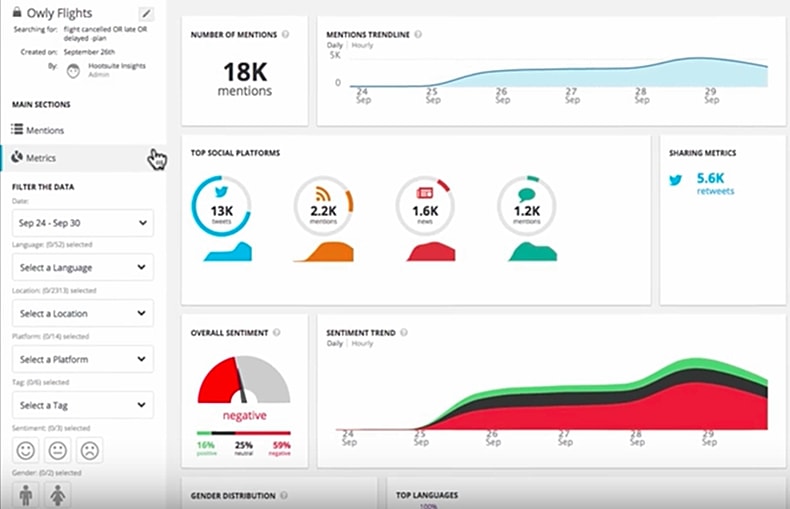
Hootsuite is a popular social media management platform. Its main focus is on managing a brand's social activity, but audience analysis is also one of its benefits. Accordingly, Hootsuite Insights analyzes social media networks to reveal overall sentiment regarding your brand and the trends that surround your brand on those networks.
You can filter the information by demographic, location, and language.
Pricing: $19/month for Pro, $99/month for Team, $599/month for Business. Enterprise pricing is available upon request. Free trial available.
More Resources on Sentiment Analysis Tools
Determining Consumer Sentiment: Trends and Common Mistakes
Dark Data on Social Media: Insights That Shed Light on Your Business
10 of the Best Social Media Monitoring Tools for Every Business




